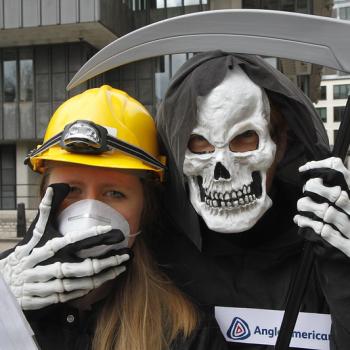When Alien, Predator, or Terminator slice up or rip apart dozens, life just goes on. Bodies fly all over the screen and we are onto the next scene. Wondering about who actually was the 11th poor soul who had his heart ripped out by the Terminator is far less interesting than watching the latter utter some banality. The same is true of everything from Die Hard to 300—lots of real-life, graphic killing, but almost no pause and bewilderment over the staggering loss of life or the consequences of Target 12 or Victim G leaving life at 12 or 56. Killing is so easy not just because of robotic arms, RPGs, and computer simulations, but also because there are almost no emotional consequences from the carnage—a fact easily appreciated by the viewer, the more so if young or unhinged or both. The killer usually smiles or at least shows no emotion; the victims are reduced to “them,” anonymous souls who serve as mere numbers in a body count. Will Kane’s victims, in contrast, were known—evil, but still not anonymous and not mere sets for the sheriff’s gunplay.
For the diseased mind that is saturated with such modern imagery, there is fascination aplenty with the drama of killing, but no commensurate lesson gleaned from its sheer horror—at least in human terms of the devastation that such carnage does to humans, both nearby and in the larger community. In the awful mind of the rampage killer, he always must be the center of attention in the manner of his homicidal fantasy counterpart, his victims of no more account than are those decapitated, dismembered, or shot apart by Freddy Krueger or Arnold Schwarzenegger. How odd that we rush to the emergency room for a cut finger in the kitchen—stitches, tetanus shot, pain killer, bandages, a doctor’s reassurance—only to matter-of-factly watch horrific wounds on television that night with no thought that a .38 slug to the shoulder entails something more than our split forefinger.
And there is a further wrinkle to these hyper-realistic cinematic rampages. The killer, be he an evil “Joker,” the horrific Alien, or a hit man in a mafia movie, has a certain edgy personality, even a sick sort of intriguing persona—at least in the sense that his evil is sometimes “cool” in a way that his plodding victims, who simply got in his way, are not. In the abstract, we sympathize with the good, who became his targets; but in the concrete, the film focuses more often on the killer’s emotions, his language, his swagger.
The Joker spits, he puns, he acts disengaged and “cool,” while his victims scream and panic; we want to know why he acts so, and are supposed to be fixated on his strange clothes, face, and patois, never on the series of Joe Blows that are incinerated by him. Is it any wonder we know all about the orange hair of the suspected killer, but very little about the hair colors of any of the poor victims?
via Works and Days » The Demons of the Modern Rampage Killer.











